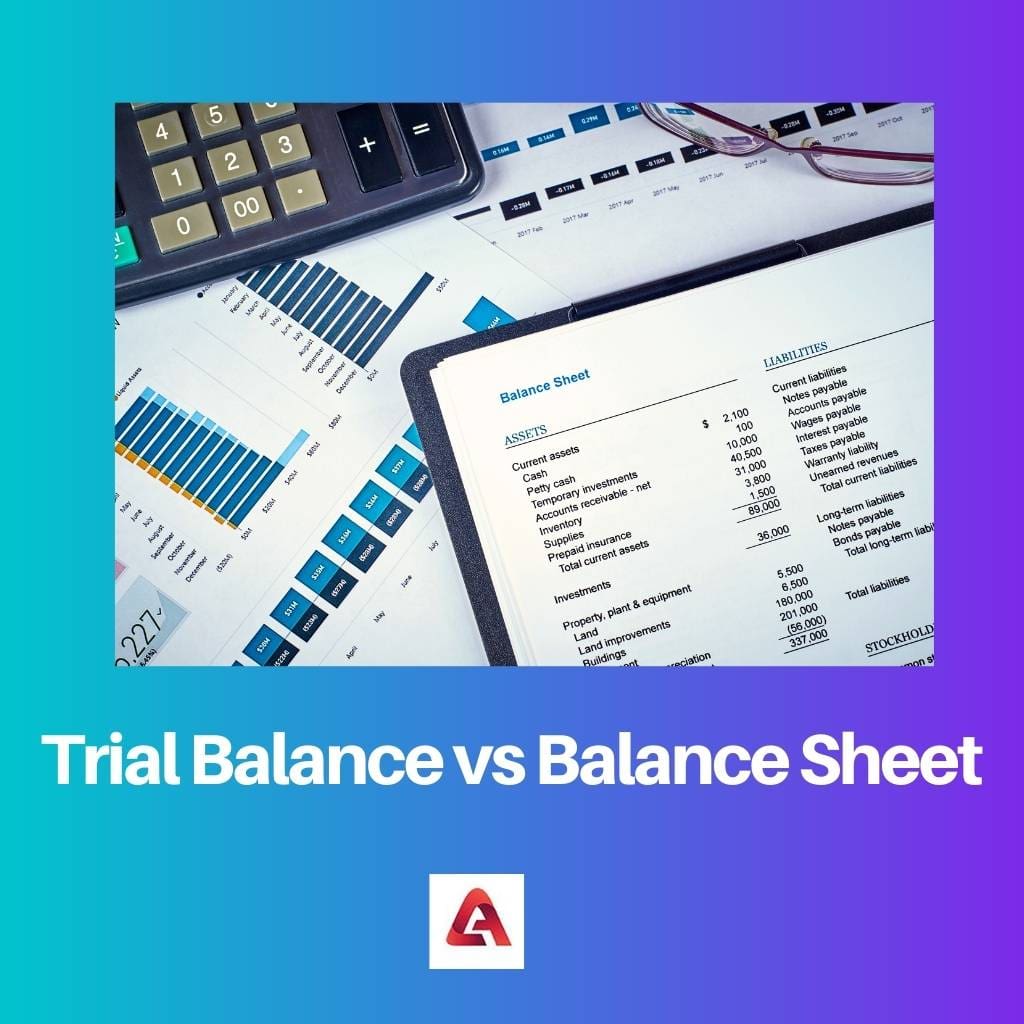The expansion of commerce beyond territorial limits required adequate procedures for bookkeeping. The bookkeeping system failed to cope with the mammoth growth of commerce.
To efficiently record the complex and increasing transactions with other countries, the double-entry bookkeeping system came into being. In the modern-day world, a trial balance and a balance sheet are two types of double-entry bookkeeping procedures.
Key Takeaways
- A trial balance is a statement of all the accounts in the ledger with their debit or credit balances. In contrast, a balance sheet is a statement of assets, liabilities, and equity at a specific point in time.
- A trial balance is used to ensure that debits and credits are balanced, while a balance sheet shows a company’s financial position.
- A trial balance is an internal document, while a balance sheet is an external document used by investors and creditors.
Trial Balance vs Balance Sheet
A trial balance is a statement that lists all the ledger accounts and their balances to ensure that the total debit balance equals the total credit balance. The balance sheet lists the company’s assets and equity and provides information on the company’s financial health, liquidity, and solvency.

A trial balance entails the debit balances and credit balances from the company’s general ledger. The law dictates that it is not mandatory for a company to prepare a trial balance.
A trial balance sheet is divided into the ‘debit’ and ‘credit’ columns to record the same on certain dates.
A balance sheet is a detailed statement of a company’s total assets and liabilities, along with the capital that is put in by the company’s shareholders.
The law concerning balance sheets provides that all companies must maintain a balance sheet. A balance sheet is divided into three columns of ‘total assets’, ‘total liabilities’, and ‘stockholders’ equity’.
Comparison Table
| Parameters of Comparison | Trial Balance | Balance Sheet |
|---|---|---|
| Meaning | A sheet bearing records of the balances of both credit and debit of a company that is taken from the ledgers on certain dates | A statement of the complete liabilities and assets of the company along with the capital that the shareholders put into it. |
| Purpose | To cross-check for any mistakes that could have happened while entering the debit or the credit details. | It gives an idea about the financial condition of the company to the existing as well as potential investors. |
| Source | General ledgers | Trial balances are taken into consideration |
| Authorization | It does not require an auditor’s authorization | Requires an auditor’s authorization |
| Format | It must be divided into Credit and Debit columns | Must be under heads as- Total Assets, Total Liabilities, and Stockholders’ Equity |
What is Trial Balance?
Trial balance is a type of double-entry bookkeeping procedure that was introduced to efficiently track and record a company’s balances (both credit and debit) while dealing with other national and international companies.
It is a statement containing the balances (both credit and debit) of a company that is taken from its ledger accounts. A trial balance is divided under the heads of Credit and Debit.
Trial balance proves to be very crucial in detecting any mistake that could have taken place during the entry of the balances. However, it is not a part of the company’s finalized accounts.
It is only used for the internal purposes of a company. Therefore, it is not necessary to take an auditor’s authorization to prepare a trial balance.
The basic information to prepare a trial balance is taken from the company’s ledgers. It is taken into account to ensure that, in the end, the total liabilities as against the total debit balances should be an equal amount.
Trial balances are made on a certain specific date of a month. Generally, the last date of a month or a year is preferable.
A unique aspect of a trial balance is that the law does not require a company to mandatorily prepare it. It is the company’s choice. Therefore, there is no set arrangement of ledger balances to be followed while preparing a trial balance.

What is Balance Sheet?
A balance sheet, like a trial balance, is a type of double-entry bookkeeping system, but it differs from a trial balance in almost every respect.
It is a statement that entails the details about a company’s total liabilities as against its total assets, along with the total capital that is put in by the shareholders in the company.
It is therefore divided into three heads: Total Assets, Total Liabilities, and Stockholders’ Equity.
The balance sheet comes in really handy to a company when it has to demonstrate its existing financial situation to retain as well as attract prospective investors.
It is regarded as a company’s financial statement, and when the accounts are being finalized, a balance sheet forms a part of it.
The law requires that all companies prepare balance sheets, and it needs to be authorized by an auditor.
Trial balance acts as a major source to make a balance sheet.
The purpose that a balance sheet serves is that it indicates the company’s financial situation and also depicts the accuracy of its financial affairs.
A balance sheet is ideally prepared on the last day of a financial year, and it is of utmost importance to follow the set arrangement of total assets, liabilities, and stockholders’ equity.

Main Differences Between Trial Balance and Balance Sheet
- A trial balance contains the records of the balances (both credit and debit) of a company that is taken from the company’s ledger accounts. On the other hand, a balance sheet is a detailed sheet containing the statements depicting the total assets as against the total liabilities of the company, and sometimes also includes the total capital that is put in by the existing shareholders in it.
- While a trial balance cannot be considered as a part of a company’s financial statements, a balance sheet is that detailed sheet that is called the financial statement of a company.
- Opening stocks are taken into consideration while preparing a trial balance. In contrast, closing stocks are considered while preparing a balance sheet.
- A trial balance displays the “real”, “nominal”, and “personal accounts”, whereas only the “real” and “personal” accounts are displayed in a balance sheet.
- Where companies use a trial balance as a reference to their internal financial affairs, a balance sheet is prepared to give an overall insight into the company’s existing situation, thereby making it useful for external affairs.


The detailed explanation of both the trial balance and balance sheet in the article is truly enlightening. The insights into their purpose, format, and preparation are valuable for understanding these financial documents within a business context.
I agree, Eleanor. The article does a great job of breaking down the intricacies of the trial balance and balance sheet, providing essential knowledge for businesses and financial professionals.
The detailed breakdown of the trial balance and balance sheet in the article is truly informative. It helps to gain a clear understanding of the crucial role of these financial documents in financial management.
The article delivers a comprehensive comparison between the trial balance and balance sheet, emphasizing their distinct functions and importance. The explanation on the preparation and the format of these financial statements is highly informative.
I agree, Smatthews. The article effectively communicates the nuances of the trial balance and balance sheet, providing valuable insights into their roles in financial reporting.
The article does a great job of highlighting the significance of the trial balance and the balance sheet. The in-depth explanation of the purpose and source of each financial statement is valuable. It’s clear that these documents serve different functions within a company’s financial reporting.
Absolutely, Fedwards. The article effectively communicates the specific roles and importance of both the trial balance and balance sheet in a company’s financial management. It’s quite informative.
I found the information on the purpose of the trial balance and balance sheet to be very elucidating. It’s essential for businesses to understand the differences and how each document is utilized for financial analysis.
The article delivers an in-depth comparison between the trial balance and balance sheet, emphasizing their individual roles and functions. The information on the meaning, purpose, and format of both financial documents is highly educational.
Absolutely, Kevin. The article offers a comprehensive breakdown of the trial balance and balance sheet, providing clarity on their specific roles and requirements. It’s certainly a valuable source of information.
I found the article to be an insightful resource for understanding the significance and principles of the trial balance and balance sheet. It’s certainly valuable for business owners and finance professionals.
The article delivers a thorough analysis of both the trial balance and balance sheet, shedding light on their purposes, format, and necessity within financial management. The comparison table is a useful reference for understanding the distinctions.
Absolutely, Oscar. The article effectively outlines the legal requirements and the specific formats for these financial documents, providing a clear understanding of their roles in financial reporting.
I found the insights into the necessity and authorization requirements for both the trial balance and balance sheet to be particularly enlightening. It’s definitely a well-rounded explanation.
The article provides a comprehensive overview of both the trial balance and balance sheet. The information on the meaning, purpose, and authorization requirements is enlightening. I appreciate the detailed comparison table as well.
The article provides a detailed account of the differences between the trial balance and balance sheet. The manner in which it explains the purpose and format of these financial statements is exemplary. The information is definitely enriching.
I completely agree, Edward. The comprehensive breakdown of the trial balance and balance sheet components will be beneficial to those seeking clarity on financial reporting requirements.
The article provides a comprehensive comparison between trial balance and balance sheet. It’s interesting to learn about the specific functions and purposes of each, as well as their different authorization requirements. The information on the format and preparation of both balance sheet and trial balance is also very informative.
The comparison table provides a clear visual aid to understand the differences between the trial balance and balance sheet. The details on the authorization requirements will be particularly useful for companies.
I agree, Hill. The distinction between the trial balance and balance sheet is made very clear in this article. It’s helpful to have all this information in one place.
The article presents a detailed comparison between the trial balance and balance sheet, elucidating their significance and the specific purposes they serve within financial management. The insights into the authorization and format requirements are particularly beneficial.
Absolutely, James. The article provides a comprehensive understanding of the necessity and preparation processes for both the trial balance and balance sheet. It’s an excellent resource.